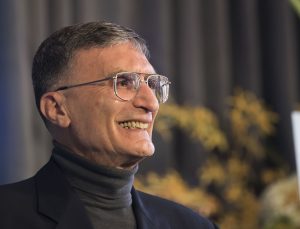, the Sarah Graham Kenan Professor of Biochemistry and Biophysics at the University of North Carolina School of Medicine and member of ������ Lineberger Comprehensive Cancer Center, has been named the 2019 recipient of the Hyman L. Battle Distinguished Cancer Research Award.

Sancar, who is one of two faculty members from the ������-Chapel Hill to win a Nobel Prize, was recognized for his distinguished career in science and discoveries in the field of DNA repair.
Sancar was honored at a reception in the cancer center atrium on Friday that drew faculty and leaders from ������ Lineberger and ������.
“It is delayed, but appropriate, that this year’s Hyman Battle Award goes to Aziz Sancar, who has done so much directly relevant cancer research,” said , director of ������ Lineberger, at Friday’s reception.
The Battle award, which includes a $25,000 prize, was established in 2007 by the Battle Foundation of Rocky Mount to recognize exceptional cancer research at the University of North Carolina at Chapel Hill. The Battle award fund is a permanent endowment held by .
Hyman L. Battle (1896-1972) established The Battle Foundation in 1946. His grandfather, Kemp Plummer Battle, was an early president of ������-Chapel Hill, and both Kemp and Hyman were deeply interested in education.
“I have to say that I talk about you all the time, every time I can when I talk about ������, and how proud we are to have you on the faculty,” said ������ Lineberger’s Blossom Damania, PhD, Boshamer Distinguished Professor in the ������ and vice dean for research, also speaking at Friday’s reception.
Research and achievements
In Sancar’s award notification letter, Damania and Earp championed Sancar’s significant scientific contributions made over the course of his career.
His work “advanced the understanding of the fundamental molecular mechanisms of DNA excision repair, delineating the circadian clock and its molecular links to DNA repair and which have provided a foundation for new approaches to cancer chemotherapy,” they wrote.
������ Lineberger’s, professor and chair of the ������ Department of Biochemistry and Biophysics, wrote in her award nomination letter that Sancar, in addition to his early scientific discoveries of DNA repair mechanisms, has continued to publish novel and exciting work, including “mapping the sites of DNA repair over the entire human genome.”

“This information is being used to identify specific mechanisms that allow cancer cells to repair DNA damage from UV radiation and chemotherapy,” Parise said. “These new studies hold great promise in translational medicine and could lead to better drugs or the ability to make cancer cells more sensitive to existing drugs.”
To recognize his scientific achievements, Sancar was presented with the Nobel Prize in Chemistry in 2015 for his work showing how in bacteria, certain enzymes can repair DNA that has been damaged by ultraviolet light.
“Your friends and colleagues are proud of the broad impact of your research, which is recognized internationally by many prizes and awards, including the 2015 Nobel Prize in Chemistry that both shined a spotlight on your work, and the quality of science at our university,” Damania and Earp wrote.
Background
Sancar was born the seventh of eight children in Turkey. His father, a farmer, and his mother, who took care of the children and house, did not receive formal education but encouraged their children’s studies. Sancar received his medical degree at Istanbul University School of Medicine in 1969.
He practiced medicine in Turkey before earning a NATO Fellowship to work at Johns Hopkins University. He pursued a doctorate at the University of Texas at Dallas, where he worked under the late Claud S. Rupert, PhD, to study the process by which DNA damaged by UV light can be repaired by longer wavelength blue light in bacteria. It was at UT-Dallas that he met Gwendolyn Boles Sancar, MS, PhD, now his wife, and a ������ professor emeritus.
His interest in DNA repair grew. Through postdoctoral work at Yale University, he identified and cloned several E. coli repair genes.
Aziz and Gwen Sancar joined the faculty at ������-Chapel Hill in 1982. Earp said Mary Ellen Jones, PhD, the then head of the biochemistry department and the first female department chair at ������, was key to bringing them to ������.
“Obviously Mary Ellen Jones recognized at the time that this was a couple that would change the face of research at ������,” Earp said.
At ������, Sancar carried out “seminal work” on the biochemistry of DNA repair, according to Parise’s nomination. In 1996, he published a study that described a mechanism of human DNA repair known as “excision” repair.
Sancar’s scientific accomplishments include discovering that the cancer drug cisplatin kills cancer cells by disrupting nucleotide excision repair. He also is known for his work – a group of enzymes that keep us in proper rhythm with the 24-hour day and the four seasons.
“It is with great pleasure that we are giving this award,” Earp said. “This isn’t an award for past work that you’ve done that’s not inconsequential … Aziz’s recent papers, as recent as last year, and actually this past week, have used the infrastructure in genomics … to do first-class research.”
Media Contact: Laura Oleniacz, Science Communications Manager at Lineberger Comprehensive Cancer Center
